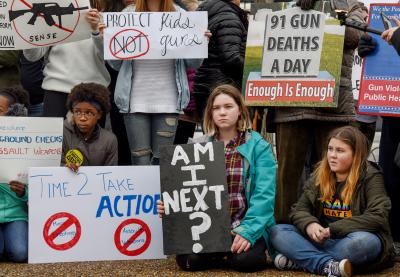The Birmingham Children's March was one of the most celebrated and effective marches in U.S. civil rights history. African-American protesters in Alabama were grief-stricken and weary; their brave organizing efforts had been met with harassment, job loss and violent retaliation. But when their children took to the streets by the thousands, filling the jails and enduring fire hoses and beatings, they drew the nation's eye—and sympathy—in a way their parents could not.
As the country witnessed the violent tactics employed by white supremacist law enforcement agents (led by Birmingham's Commissioner of Public Safety Bull Connor), pressure mounted on the business community, eventually leading to fruitful negotiations between local and civil rights leaders.
It was one of many moments in history when the kids of the community accomplished what the grown-ups could not.
Another such moment is unfolding in real time. Within hours of the February 14 mass shooting at Marjory Stoneman Douglas High School in Parkland, Florida, survivors channeled their cries of grief and despair into one united voice. We're done. This ends now. Never again.
Last week, when news of the shooting broke, it was the nation that was weary. Weary of how commonplace these events have become, how deadly, how inexplicable—and how unlikely to evoke any legislative response whatsoever, much less gun control.
But students of Stoneman Douglas are the opposite of weary. They are energized, determined, willing to demand what many adults assume will never be granted. They may very well accomplish what the grown-ups could not with the simplicity and visibility of their message to lawmakers: "It is your job to protect us, and you are FAILING."
And they're walking their talk: Today, hundreds of students took their message to the state Capitol in Tallahassee, and thousands more plan to take it all the way to Washington, D.C., next month.
This is also an important moment for educators, whether or not they choose to march alongside their students or weigh in on the debates about how to make schools safer.
It is important because it is a chance to celebrate the power of young voices—in real time—speaking about an issue that touches almost every child and educator in the United States.
It is important because it offers the opportunity to make connections to other moments in history, from the Children's March and the anti-Vietnam War movement to more modern examples, like the Dream Defenders organizing for equality in Florida and the Water Protectors who protested the North Dakota Access Pipeline at Standing Rock.
It is important because millions of U.S. children live with gun violence daily, and students may well ask hard questions about why we as a nation respond differently to sudden incidents of mass violence than we do to everyday exposure to violence and loss over time. We owe them educated answers.
It is important because, even as we applaud and support this incredible moment of youth activism, we must maintain an intersectional lens. This means acknowledging that the voices of Parkland students have been amplified by a media culture that often lends its megaphone to those who look and sound like them, and that we still have to work to ensure that all students' voices are valued and heard.
It is important because students who may never have previously seen themselves as change agents may experience a shift in self-perception, and we can be there to help channel their energy into action.
Of all the adults in the country right now, educators may be the weariest of all—and with good reason. But watching the students of Parkland take the lead—along with the cadre of young activists they've inspired nationally—offers us all a moment to pause and feel hopeful. It also offers an opportunity to support our students and give them the knowledge and the tools they need to change their communities for the better.
As history has shown us, this isn't a rhetorical exercise. Our students may well be the ones who accomplish what we cannot.
van der Valk is the deputy director for Teaching Tolerance.
